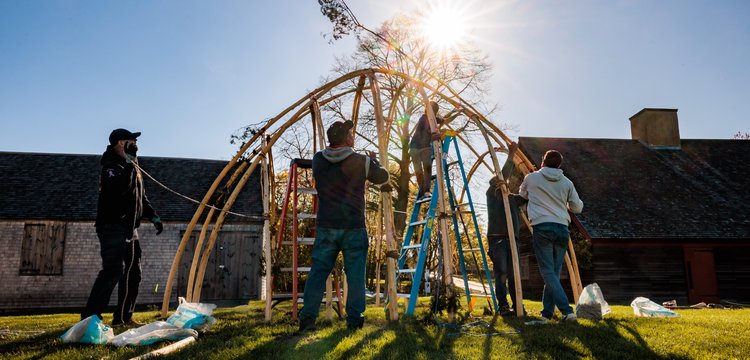
Wetu at CAM Green
Mashpee Wampanoag partners visited the Cape Ann Museum Green in May 2023 to build a wetu (traditional home) as part of Native Waters; Native Lands, a collaborative partnership between the Cape Ann Museum, the Gloucester 400+ Anniversary Committee, Discover Gloucester, the City of Gloucester, and SmokeSygnals, a Native production company.
As Steve Peters, Creative Director of SmokeSygnals describes, the wetu is “a structure that’s inviting for the community to come in, sit, have a picnic, and enjoy how comfortable life was as Indigenous people here more than 400 years ago. That’s key, we want people to know that we’ve been here for thousands of years, that history didn’t start when the Europeans arrived. And this structure that we have behind us now for everyone to see as they’re coming around the rotary and around the Cape Ann Museum is a symbol of that.”
Peters, along with Darius Coombs, Russell Peters, and several community members and kids, spent four days on Cape Ann installing the wetu frame and benches. Prior to arrival, they responsibly harvested 35 white cedar saplings from Southeastern Massachusetts and peeled the bark off to make the poles last longer. The cedar bark can then be used to make baskets or mats. Without the bark, the saplings bent into the wetu frame can last over ten years.
The finished frame measures ten feet in height, sixteen feet long, and twelve feet wide. The saplings are lashed together with artificial sinew made of nylon, mimicking what would have traditionally been done with natural sinew from a deer or other large animal.Traditionally, the wetu frame would have been covered with chestnut or elm bark, which has to be harvested in the spring or early summer when sap running up the trees makes it easier to peel off the bark.
A wetu this size would have been a home for a family of four. As Darius Coombs explains, “Inside, you would have had the fire pit, the bedding. On the bedding you would’ve had furs. A lot of deer, a lot of black bear, moose, elk. You would’ve seen cooking utensils, clay pots, ladles, stirring paddles. You would’ve seen basketry all around for storage, hemp bags, bows and arrows for hunting. Whatever you needed in your personal life when it was inside your house. Most of your life is spent outside. You lived outside. You went inside when the weather conditions would get severe. You’d even cook outside a lot."
Visitors are invited to enter the wetu and take a seat on the benches whenever the CAM Green is open. The wetu will be joined by a traditional mush8n (dugout canoe) built by SmokeSygnals for the Gloucester 400+ Anniversary’s Celebration of Place: The Cultural Heritage Festival this fall. After being displayed at Stage Fort Park and Gloucester City Hall, the mush8n will be on display next to the wetu at CAM Green through 2025 to complete the Native Waters; Native Lands initiative.
Built as part of the city-wide efforts to mark 400 years since English colonizers first attempted to settle the land that is now called Cape Ann, the wetu emphasizes the continuous Native history and practices of the region, dating back over 10,000 years and active today. It is placed between the historic White-Ellery House (1710) and Babson-Alling House (c. 1740s) to encourage thoughtful consideration of how all of the people on Cape Ann lived historically, how we live together today, and how we can build a better future together.
This project is generously funded by the Essex County Community Foundation’s Creative County Initiative, the City of Gloucester, and the Cape Ann Museum.